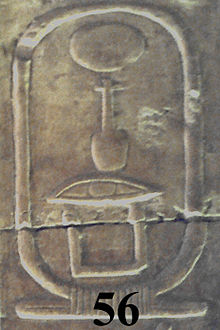Neferirkare
| Neferirkare | ||||||||||||||||||||||||||||||||||||||||||||||||||||||||||||||||||||
|---|---|---|---|---|---|---|---|---|---|---|---|---|---|---|---|---|---|---|---|---|---|---|---|---|---|---|---|---|---|---|---|---|---|---|---|---|---|---|---|---|---|---|---|---|---|---|---|---|---|---|---|---|---|---|---|---|---|---|---|---|---|---|---|---|---|---|---|---|
| Neferirkare II | ||||||||||||||||||||||||||||||||||||||||||||||||||||||||||||||||||||
 The cartouche of Neferirkare on the Abydos King List. | ||||||||||||||||||||||||||||||||||||||||||||||||||||||||||||||||||||
| Pharaoh | ||||||||||||||||||||||||||||||||||||||||||||||||||||||||||||||||||||
| Reign | 1 year and 6 months, c. 2160 BC | |||||||||||||||||||||||||||||||||||||||||||||||||||||||||||||||||||
| Predecessor | Neferkauhor | |||||||||||||||||||||||||||||||||||||||||||||||||||||||||||||||||||
| Successor | uncertain; possibly Meryibre Khety | |||||||||||||||||||||||||||||||||||||||||||||||||||||||||||||||||||
| ||||||||||||||||||||||||||||||||||||||||||||||||||||||||||||||||||||
| Burial | unknown | |||||||||||||||||||||||||||||||||||||||||||||||||||||||||||||||||||
| Dynasty | Eighth Dynasty | |||||||||||||||||||||||||||||||||||||||||||||||||||||||||||||||||||
Neferirkare (sometimes referred to as Neferirkare II because of
Attestations
Neferirkare II's name is clearly attested on the 56th entry of the Abydos King List, a king list which was redacted some 900 years after the First Intermediate Period during the reign of Seti I.[2] The latest reconstruction of the Turin canon, another king list compiled in the Ramesside era, indicates that Neferirkare II is also attested there on column 5, line 13.[1][2]
Identity
Farouk Gomaà, William C. Hayes and Baker identify Neferirkare II with the horus name Demedjibtawy (Dmḏ-ib-t3wy, "He who unifies the heart of the two lands") appearing on a single decree, the Coptos Decree R, now in the Egyptian Museum, JE 41894. The decree concerns the temple of Min at Coptos, exempting it from dues and duties.[5][6][7][8][9] This identification is rejected by Jürgen von Beckerath.[10]
Another proposed identification concerns the prenomen
Finally, both Demedjibtawy and Wadjkare are not known from any other contemporary attestation than the decree and, unless they are to be identified with Neferirkare II or Neferkare II, they are also absent from both the Abydos king list and the Turin canon.
In 2014 Maha Farid Mostafa published an inscription, found in the tomb of Shemay. The inscription belongs most likely to Idy, a son of Shemay, albeit Idy's name is not preserved. The text is dated under a king with the name Pepy and with a throne name Nefer-ka [destroyed]-Ra. Maha Farid Mostafa reconstructed that throne name to Neferirkare. The inscription dates for sure to the 8th Dynasty. If this reconstruction is correct, Neferirkare is most likely identical with Demedjibtawy. Idy is mentioned on one of the Coptos decrees together with Demedjibtawy .[14]
Reign
The Turin canon credits Neferirkare II with a year and half of reign.
References
- ^ a b c Kim Ryholt: "The Late Old Kingdom in the Turin King-list and the Identity of Nitocris", Zeitschrift für ägyptische, 127, 2000, p. 99
- ^ ISBN 978-1-905299-37-9, 2008, p. 260
- ^ see p. 68
- ^ Renate Mueller-Wollermann: End of the Old Kingdom, UCLA Encyclopedia of Egyptology (2014), available online.
- ^ ISBN 3-88226-041-6, p. 59.
- ^ William C. Hayes: Royal Decrees from the Temple of Min at Coptus, JEA, vol. 32, 1946.
- ^ Coptos decree R, translation available online Archived 2018-07-26 at the Wayback Machine, after M. A. Moret: "Chartes d'immunité dans l'Ancien Empire égyptien", in Journal Asiatique, 1917 (Sér. 11/T.10), Paris
- ISBN 9004130489
- ^ William C. Hayes: The Scepter of Egypt: A Background for the Study of the Egyptian Antiquities in The Metropolitan Museum of Art. Vol. 1, From the Earliest Times to the End of the Middle Kingdom, p. 134, available online
- ^ a b c Jürgen von Beckerath: The Date of the End of the Old Kingdom of Egypt, JNES 21 (1962), p. 143
- ISBN 1438109970, p. 429, available online
- ^ Hans Goedicke: Königliche Dokumente aus dem Alten Reich (= Ägyptologische Abhandlungen, Bd. 14). Harrassowitz, Wiesbaden 1967, p. 215.
- ISBN 3-491-96053-3.
- ISBN 978-977642004-5, p. 157-161

